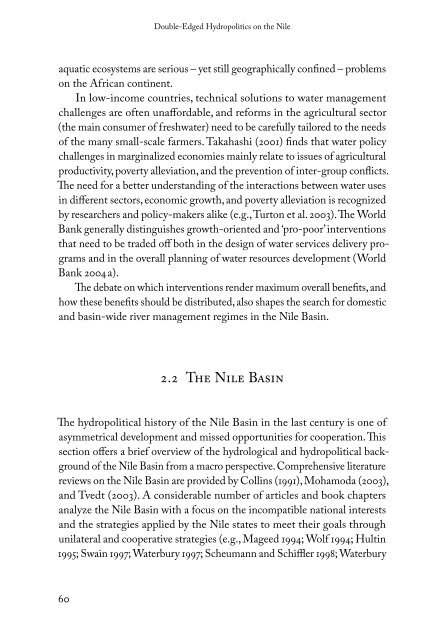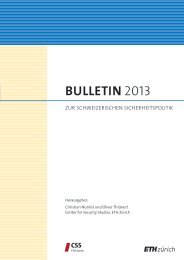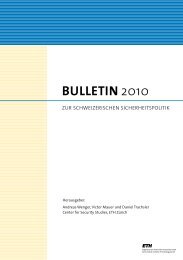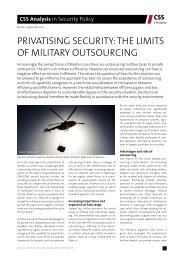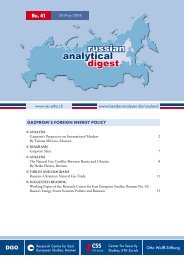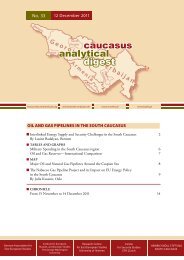Double-Edged Hydropolitics on the Nile - Center for Security Studies ...
Double-Edged Hydropolitics on the Nile - Center for Security Studies ...
Double-Edged Hydropolitics on the Nile - Center for Security Studies ...
Create successful ePaper yourself
Turn your PDF publications into a flip-book with our unique Google optimized e-Paper software.
<str<strong>on</strong>g>Double</str<strong>on</strong>g>-<str<strong>on</strong>g>Edged</str<strong>on</strong>g> <str<strong>on</strong>g>Hydropolitics</str<strong>on</strong>g> <strong>on</strong> <strong>the</strong> <strong>Nile</strong><br />
aquatic ecosystems are serious – yet still geographically c<strong>on</strong>fined – problems<br />
<strong>on</strong> <strong>the</strong> African c<strong>on</strong>tinent.<br />
In low-income countries, technical soluti<strong>on</strong>s to water management<br />
challenges are often unaf<strong>for</strong>dable, and re<strong>for</strong>ms in <strong>the</strong> agricultural sector<br />
(<strong>the</strong> main c<strong>on</strong>sumer of freshwater) need to be carefully tailored to <strong>the</strong> needs<br />
of <strong>the</strong> many small-scale farmers. Takahashi (2001) finds that water policy<br />
challenges in marginalized ec<strong>on</strong>omies mainly relate to issues of agricultural<br />
productivity, poverty alleviati<strong>on</strong>, and <strong>the</strong> preventi<strong>on</strong> of inter-group c<strong>on</strong>flicts.<br />
The need <strong>for</strong> a better understanding of <strong>the</strong> interacti<strong>on</strong>s between water uses<br />
in different sectors, ec<strong>on</strong>omic growth, and poverty alleviati<strong>on</strong> is recognized<br />
by researchers and policy-makers alike (e.g., Turt<strong>on</strong> et al. 2003). The World<br />
Bank generally distinguishes growth-oriented and ‘pro-poor’ interventi<strong>on</strong>s<br />
that need to be traded off both in <strong>the</strong> design of water services delivery programs<br />
and in <strong>the</strong> overall planning of water resources development (World<br />
Bank 2004 a).<br />
The debate <strong>on</strong> which interventi<strong>on</strong>s render maximum overall benefits, and<br />
how <strong>the</strong>se benefits should be distributed, also shapes <strong>the</strong> search <strong>for</strong> domestic<br />
and basin-wide river management regimes in <strong>the</strong> <strong>Nile</strong> Basin.<br />
2.2 The <strong>Nile</strong> Basin<br />
The hydropolitical history of <strong>the</strong> <strong>Nile</strong> Basin in <strong>the</strong> last century is <strong>on</strong>e of<br />
asymmetrical development and missed opportunities <strong>for</strong> cooperati<strong>on</strong>. This<br />
secti<strong>on</strong> offers a brief overview of <strong>the</strong> hydrological and hydropolitical background<br />
of <strong>the</strong> <strong>Nile</strong> Basin from a macro perspective. Comprehensive literature<br />
reviews <strong>on</strong> <strong>the</strong> <strong>Nile</strong> Basin are provided by Collins (1991), Mohamoda (2003),<br />
and Tvedt (2003). A c<strong>on</strong>siderable number of articles and book chapters<br />
analyze <strong>the</strong> <strong>Nile</strong> Basin with a focus <strong>on</strong> <strong>the</strong> incompatible nati<strong>on</strong>al interests<br />
and <strong>the</strong> strategies applied by <strong>the</strong> <strong>Nile</strong> states to meet <strong>the</strong>ir goals through<br />
unilateral and cooperative strategies (e.g., Mageed 1994; Wolf 1994; Hultin<br />
1995; Swain 1997; Waterbury 1997; Scheumann and Schiffler 1998; Waterbury<br />
60


